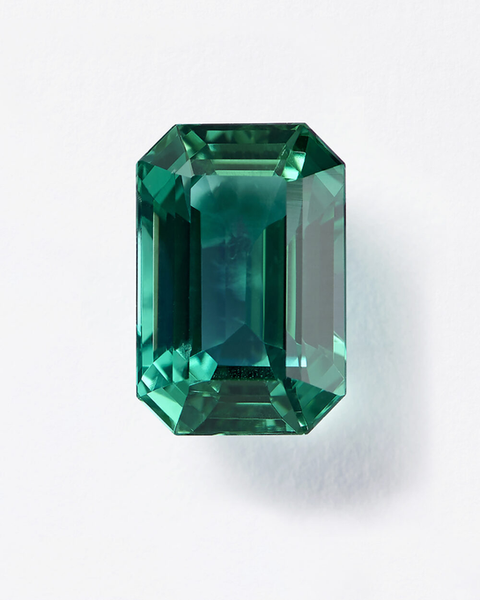Exuberant Elegance
A rare and magnificent shape, the underside of the emerald is faceted, while the top is a sleek, smooth cabochon, with this double silhouette inspiring the final configuration.
What are emeralds?
Perhaps the most famous green-hued gemstone, the emerald is a variety of the mineral beryl. Despite their relatively lower hardness on the Mohs scale compared to diamonds, emeralds are often treated with oils and resins to enhance their durability and appearance which means they can make for a rather lovely engagement ring.
This treatment helps minimize the risk of breakage and ensures the longevity of the stone. The unique characteristics of emeralds, such as their low facet structure and deep color saturation, contribute to their special appeal. Their softer brilliance and rich depth create a captivating effect that sets them apart from traditional diamond rings. With the right amount of maintenance and care, the stone will bring you joy every day. As Chandler said to Monica ‘they can say that you’re high maintenance, but it’s okay, because I like…maintaining you.’
Whether set in vintage-inspired designs or modern settings, emerald engagement rings possess a charm and class that can complement any type of metal with their beguiling green hue. From the enchanting shades that make you think of lush woodlands to the refreshing shade of iced pistachio, emeralds offer a spectrum of colors that add distinct character to any ring design.
With their distinguished reputation for striking beauty, emerald engagement rings captivate and delight in equal measure.


What are the best cuts for emeralds?
Emeralds can be brittle and feature visible inclusions; for this reason, the famous ’emerald cut’ was developed. Characterized by the step cut or the trap ring setting, it features rectangular facets and a larger table. These cuts are uniquely designed to enhance the stability and form of a stone, which allows a gem that is naturally fragile to be worn as everyday jewellery. An emerald cut engagement ring with an emerald center stone is one of the most popular styles for this particular gemstone.
Some high-quality emeralds won’t have many inclusions, allowing them to be cut in the classic round, oval or other fancy shapes. Emeralds also make beautiful side stones, which you can pair with a diamond center stone for dazzling results. We also offer them as our Signature Stone on the inside of your engagement ring’s band.
Should emeralds be dark or light?
Emeralds range from a light seafoam color to a dark mossy tone. The color of the gemstone is graded by three factors: color, tone and hue. The most prized emerald color is known as ‘very good’ or ‘exceptional’, which means it is rich with color but bright enough that it doesn’t lose its signature look. The tone of the emerald refers to the saturation of color, ranging from light to deep and intense. The hue of the emerald is what describes the exact color, and this ranges from light yellow-green to a strong verdant shade, with the most desirable being an intense bluish green.
Ultimately, there’s no right or wrong color for an emerald, as beauty is in the eye of the beholder, so it’s really up to you. Some people prefer the classic forest green hue, while some love the fire and glow of a lighter green emerald.

